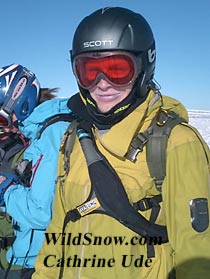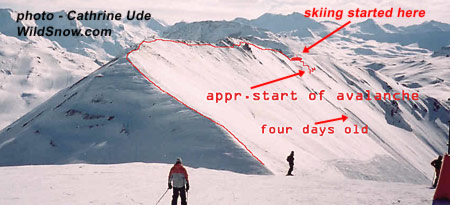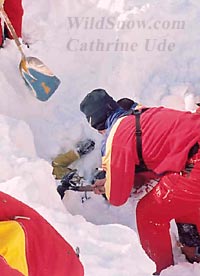WildSnow Summary: On January 29, 2005, at 12:55 PM, Martin Gulsrud of Norway was backcountry skiing an area near TUFS at the resort Tignes, France, when he was caught in an avalanche. He was buried about 2.5 meters beneath the surface for 20 minutes. Gulsrud and his group were following avalanche terrain protocol and skiing one at a time and carrying shovels, probes and avalanche beacons. More, nearby ski patrol were able to respond quickly with large shovels. Gulsrud was also wearing a Black Diamond Avalung. While all factors were important to this save, the avalung was instrumental, as Gulsrud would have suffocated without it, given this type of lengthy and deep burial. (Thanks to Backbone Media and Martin’s friends for this excellent educational report.)
Following is an email interview with Martin Gulsrud which describes his first hand experience surviving an avalanche while backcountry skiing in Tignes France on January 29, 2005. WildSnow.com received this from Backbone Media on March 2, 2005. Edited by WildSnow.com for brevity and clarity — thus copyrighted under compilation copyright of WildSnow.com. The photos are used by permission of the creator as well as Backbone Media.
Martin, please describe your past backcountry skiing experience?
I have been skiing for 19 years, and off-piste backcountry skiing for the last five, always carrying beacons, shovels and probes. In those five years, I have seen three avalanches.
Have you taken any avalanche safety courses in the past?
No I haven’t, but I have read parts of the book “Skredfare” [WildSnow.com editor’s note: a European avalanche safety book for backcountry skiers]. In Val Thorens (2004), we backcountry skied a lot with a friend (Peter) we hadn’t skied with before. He had been to an avalanche safety course held by Markus Landerø (author of “Skredfare“). We asked Peter to lead a practice session with our beacons. This was the first time many of us, (including me), trained with our beacons outside.
Did you purchase the AvaLung? If, yes, what led you to buy it?
I got my avalung for Christmas gift from my girlfriend, 2 years ago.
Did you practice with your AvaLung as you do with your avalanche beacon?
I did not practice by getting buried. I check it before each ski tour by breathing through it. I also usually breathe through it before crossing a slope I consider to be risky.

Avalanche survivor Martin Gulsrud with his Avalung.
Please describe the situation of the avalanche.
It was a sunny day, the last day of our holiday. The avalanche risk was down from 4 to 3. The backcountry skiing slope where I was buried was one we had been watching the whole week. Four days earlier there had been an avalanche next to where we wanted to ski. We saw craters in the same side which indicated they had secured this side with explosives. There had been many people skiing on the other side of the old avalanche, near the piste. Thus, we thought this side was “safe.” We knew about the high avalanche risk for backcountry skiing during this week, but we suspected conditions had stabilized, and decided to give it a try. On top of the slope we decided I would go first.
How the the avalanche propagate? Did you set it off? If so, were you skiing when it happened?
I had skied straight line for about 15 meters to gather speed, then I took 2-3 turns and it cracked around me. I was carried for approximately 200-250 meters down, and it went fast. I think I had the same speed all the way down to the bottom, where all the snow gathered in in a bowl. Reaching the bottom of the slope I was buried at once. After I was brought to the medical center, the ski patrol told my friends that the bowl where the avalanche stopped was a small frozen lake. They found a body in this lake 6 months after it had been taken by an avalanche in the same side.
Was it easy or difficult to get the mouthpiece in and breathe?
I took the mouthpiece in my mouth as soon as I noticed that I had lost all my speed relative to the avalanche, and at this moment I was still standing up. It was a huge help to breathe through the avalung while being dragged down the slope. The avalung was easy to breathe through, and I could focus on what to do when I was buried, instead of struggle with snow in my mouth and lungs.
Once you were buried did you gain a sense of calm as you were able to breathe?
YES !!! Still in the avalanche, carried down the slope in high speed, I surfaced right before reaching the bottom of the slope. At that moment I thought luckily I am not going to be buried. While surfacing I was able to turn around so i could see where I was carried. Then I saw the snow raise up like a wave when hitting the breaking end of the slope. I understood that I was going to be buried seconds later, so I started to expand my lungs so I could have space to breathe under the snow pack. At the same moment I crashed into this wall of moving snow, I was covered and the pressure started to increase. I could hear the bouldering sound of snow landing upon me and the pressure was increasing extremely fast. This sound stayed on for around 5 to 10 seconds, and during this time I concentrated on taking short and fast gasps of air with as much air in my lungs as possible.

This is perhaps the view Catherine had when she witnessed the avalanche from the top of the ski resort.
Even though I fought for the space around my lungs I ended up with less than 50% of full lung capacity. The pressure was enormous; I couldn’t move a finger or open my mouth. During the time I was carried down the slope, at the time I was buried and after it all had settled down, I didn’t use any forces trying to move the snow or position my self any different. The only thing I focused on was having space around my lungs, and I remember thinking how this would be without the avalung. I am very glad I didn’t panic and struggle against the forces of the avalanche. I was very frightened until I concluded that the snow wasn’t moving any more, I could breath and I was in a position where I cold stay alive for a while.
I was sure I was buried deep because I could hear the rumble of the avalanche getting weaker and weaker. It didn’t take long for Erik and Andreas to be standing on top of me. I cold hear through the snow that they were at the right area, and I heard over my PMR 446 radio that they were in contact with other people in our group. I heard a lot of activity in the snow but still I hadn’t felt any probes hit my body. I thought “maybe I am deeper than 3.5 meters ” (length of Erik’s probe) since they still hadn’t hit me.

Dramatic photo showing moment when Martin’s head was uncovered — after being deeply buried for about 20 minutes.
The fact was that Erik and Andreas had started to dig around 2 meters away from the pinpoint location above me. Soon Erik got some new signals from his beacon and and he used his probe again and hit my arm and shoulder at 2.5 meters. At this moment the first guy from the ski patrol came, and right after this there were 7 others digging around Erik´s probe. The ski patrol had now taken over the rescue. Andreas had this small Ortovox plastic shovel with the red blade, and Erik had a bigger aluminum folding shovel. They told me afterward that they would never be able to dig me out from where I was laying. After digging 1 meter deep, they were totally exhausted and the snow was too hard for the light shovels.
The ski patrol got there so quickly because Cathrine (Erik´s girlfriend) was sitting outside a cafe on one of the lift tops. She was watching us and had seen see the avalanche. She had contact with Erik and Andreas over PMR radios. The ski patrol had a base there, so she reported the accident the moment it happened, and the ski patrol just traversed to get to the bottom of the avalanche. This was pure luck again, as we have been skiing other places where it would have taken more time to get help. This is one of the things we will consider when going off piste in the next time.
In what position were you buried (example lying down and facing upward)?
I was buried in a sitting position with my head vertically above my back. My right leg was a bit bent backwards, but not uncomfortably. My left leg was straight and lifted, but not so high as to tear my muscles on my hamstring, and it pointed slightly to the left, seen from above. My left arm was almost straightened out, and it pointed a bit forward and upwards. My right arm I held close to my body with my right hand in a tight grip around the tube of the avalung just beneath the mouthpiece.
How long do you estimate you were buried?
I said 15 minutes before, but after meeting with my mother last weekend, she told me that when Erik and Andreas met my parents, to tell them about the accident, they concluded that was more like 20 minutes. (Third party confirmation estimates his burial was 20 minutes).
Did you feel you could have lasted longer beneath the snow?
Yes. I started to feel a bit dizzy when the rescue team reached my hand, but the rest of my body was still under the snow. I was a bit chilled by the heavy snow, and because when I had the thought that maybe I laying deeper than 3.5 meters, I was a bit concerned about the cold. (Third party confirmation estimates Gulsrud was buried under 2.5 meters of snow).
Did this experience change how you will approach skiing off piste in the future?
As I said earlier in the text, we will consider how long it will take to for help to come, and how we can contact them. Some of us had the number to the ski patrol on our mobile phones, and I believe they listen to channel 1 and 2 on the 446 band. Among the 10 people traveling together, 6 of us regularly go off piste – one of them is me – and the 5 other are not going off piste again without an Avalung and at least an aluminum shovel the size of the one Erik has.
Do you have anything else to add regarding the AvaLung or your experience?
As I lay buried under the snow I got some spit in my mouth, I was wondering whether or not I could let this spit go into the Avalung. I thought about what I had read about the Avalung in the user manual, about how it works. I concluded that the spit would be drained out through the outlet valve, the same way as my breath, so I let it go this way. Towards the end of waiting under the snow, I heard gurgling sounds from the Avalung, but I was still confident that a hard breath out would clean the pipe. I never felt this was a problem so I didn’t do anything about it.
I felt so lucky to have the Avalung both on my way down the slope, and while buried for such a long time. I was prepared to wait for a long time to get up, mostly because I felt like I was really deep, but it didn’t worry me because I believed that I would have fresh air until they finally found me. The most frightening moment of the whole accident was when I was fighting for the space around my chest. Without the Avalung, I think this would have been impossible. So even though my friends and I were lucky in this backcountry skiing experience, I do believe that none of us could have survived this avalanche without an Avalung [WildSnow.com editor’s note: And nearby ski patrol?].
Review of Black Diamond Avalung.
WildSnow.com publisher emeritus and founder Lou (Louis Dawson) has a 50+ years career in climbing, backcountry skiing and ski mountaineering. He was the first person in history to ski down all 54 Colorado 14,000-foot peaks, has authored numerous books about about backcountry skiing, and has skied from the summit of Denali in Alaska, North America’s highest mountain.
